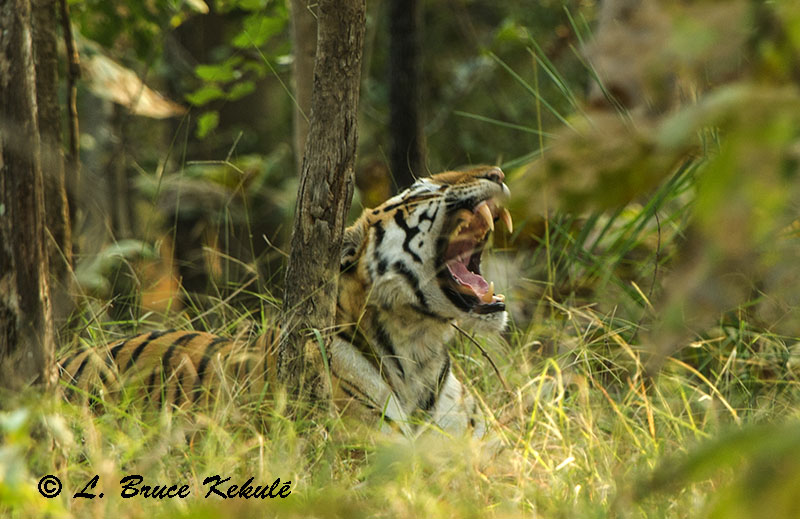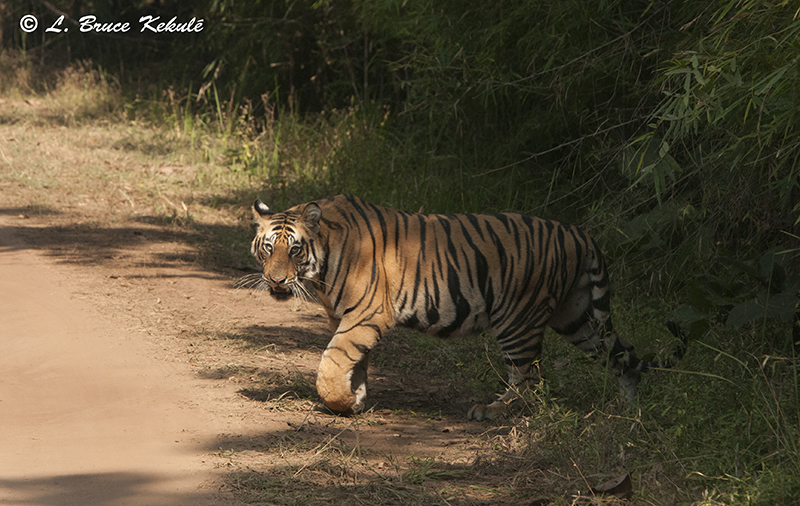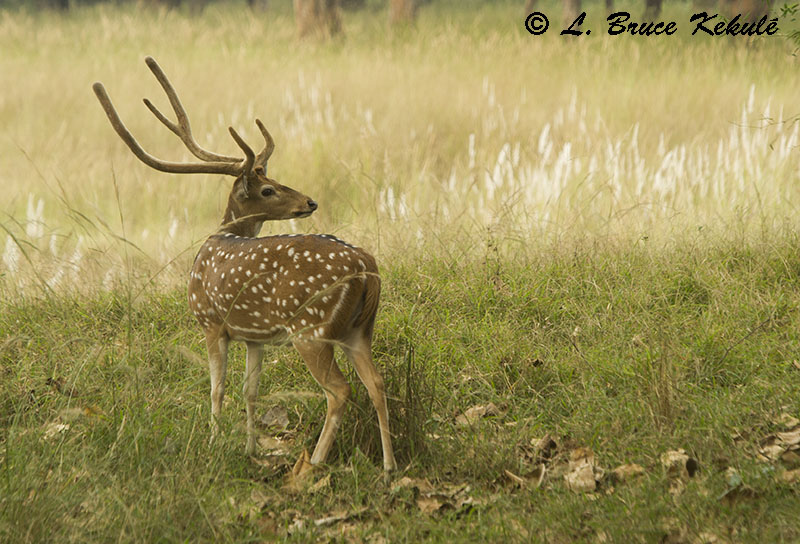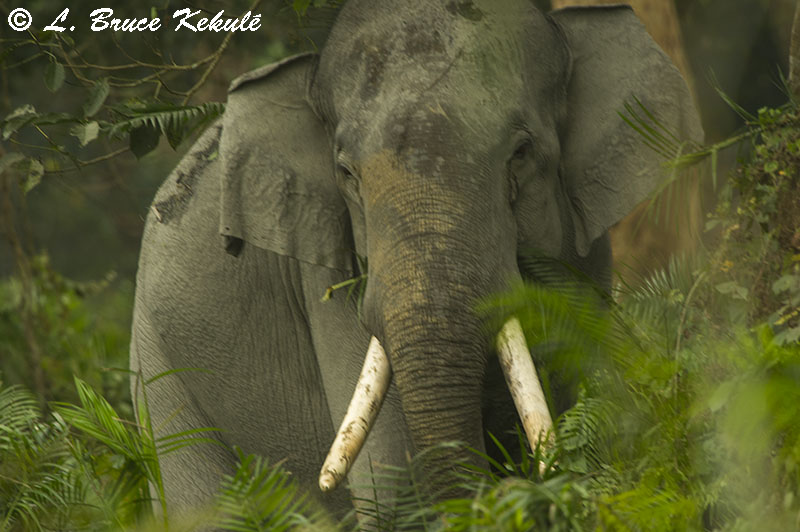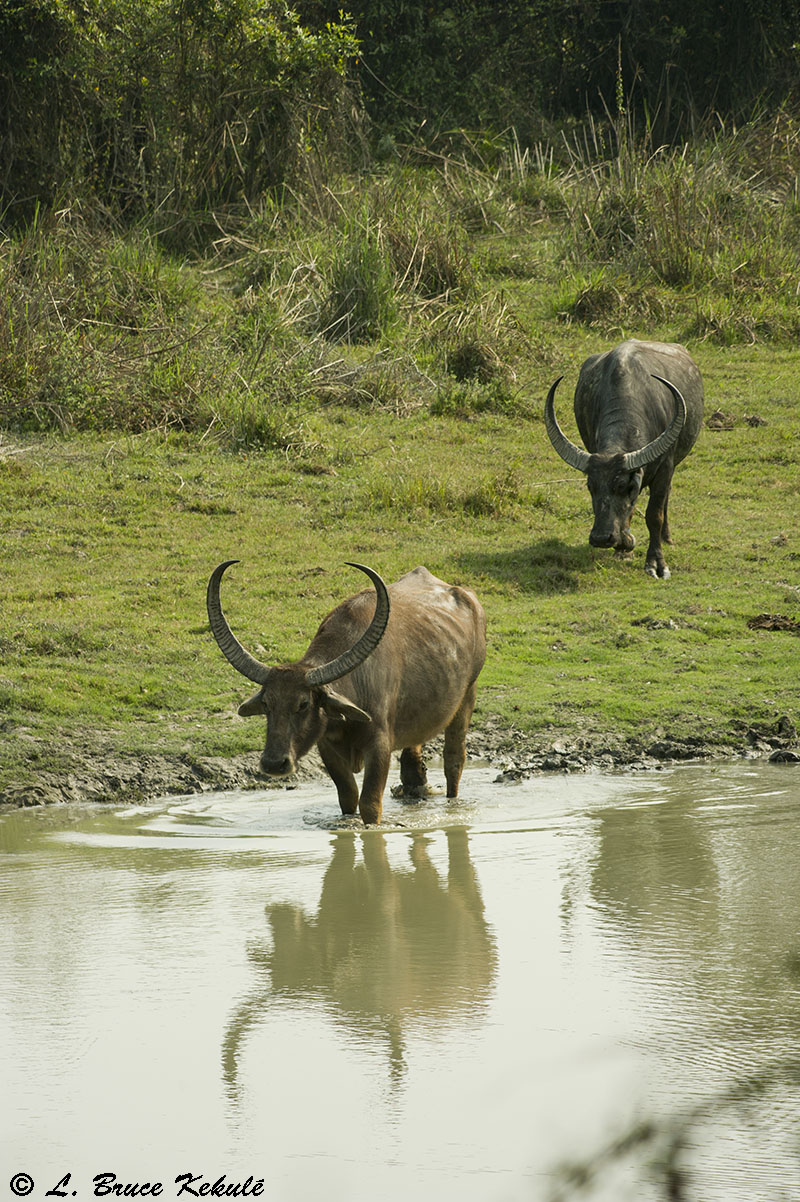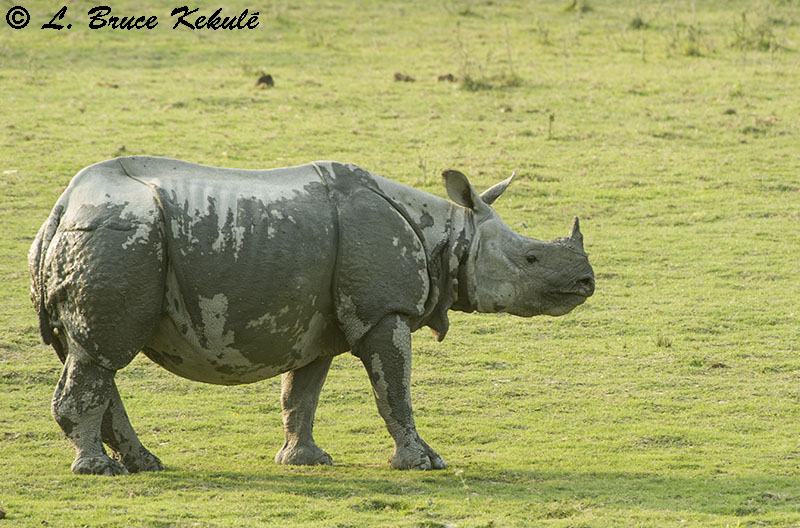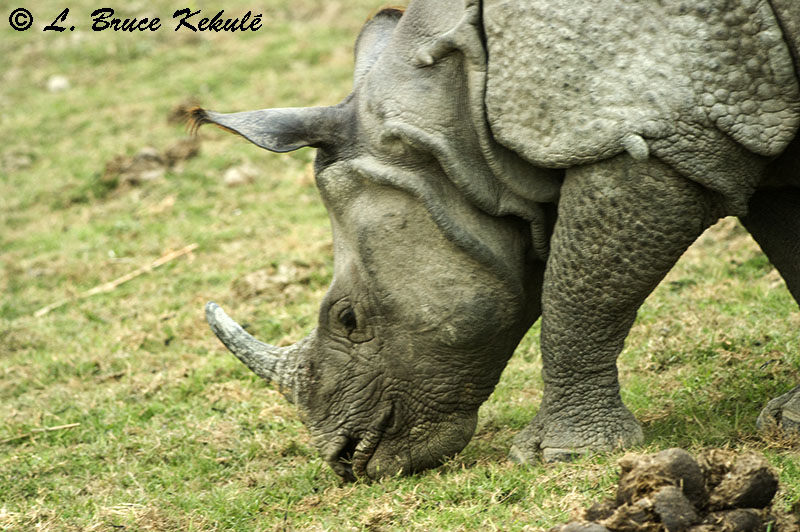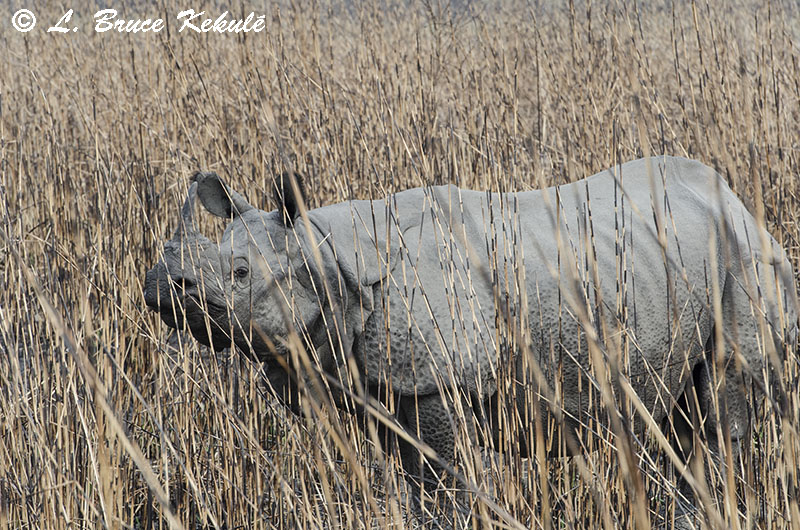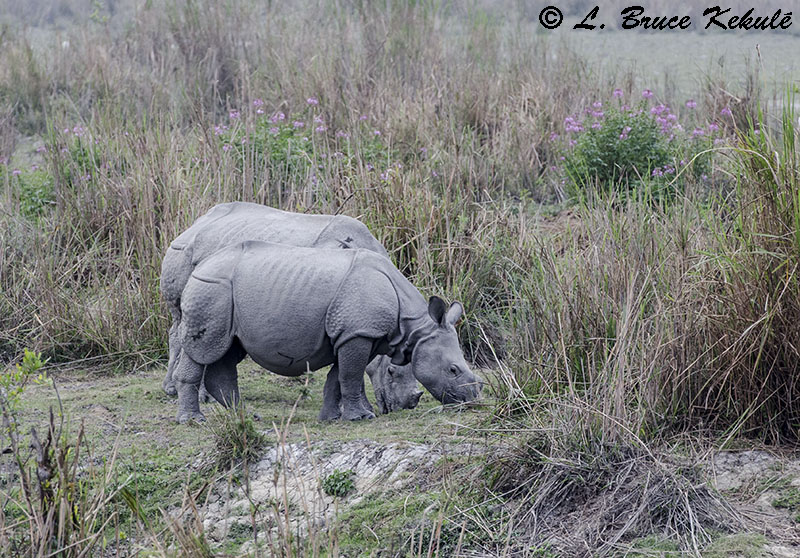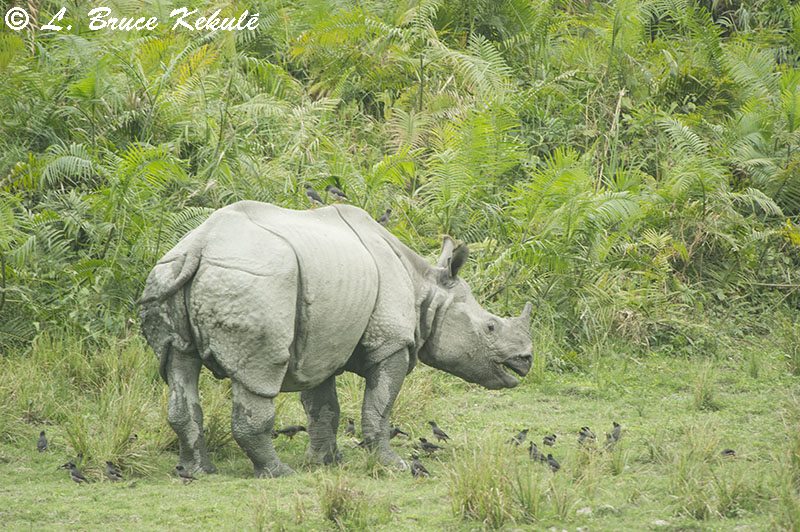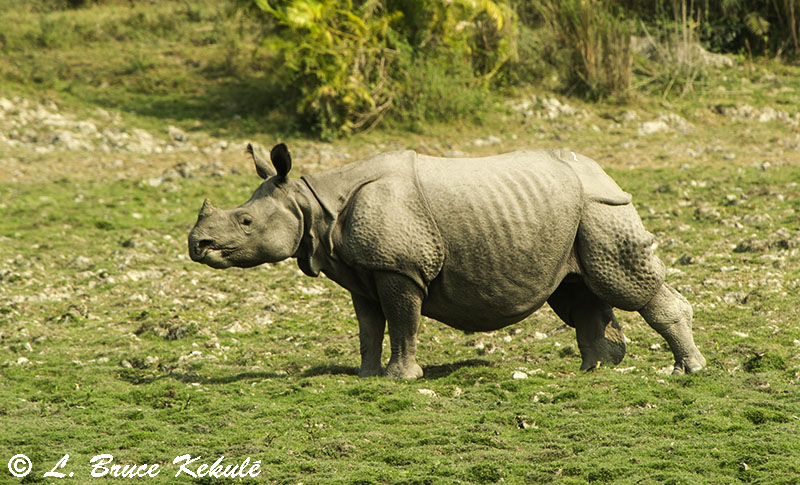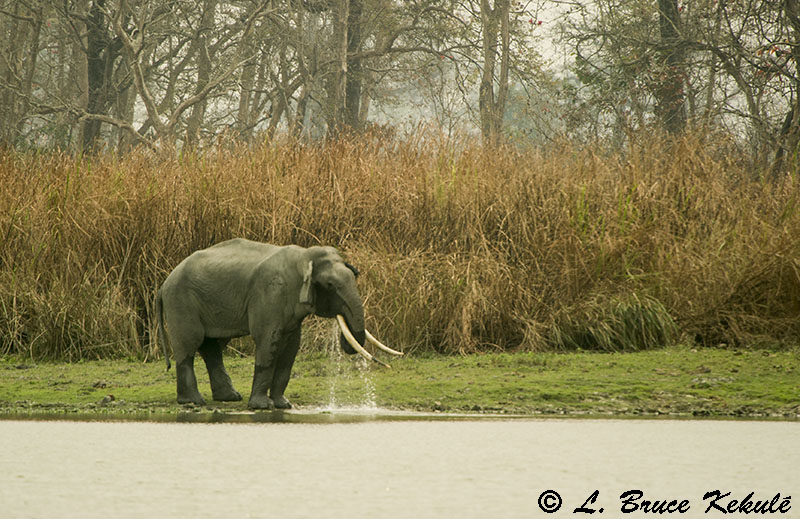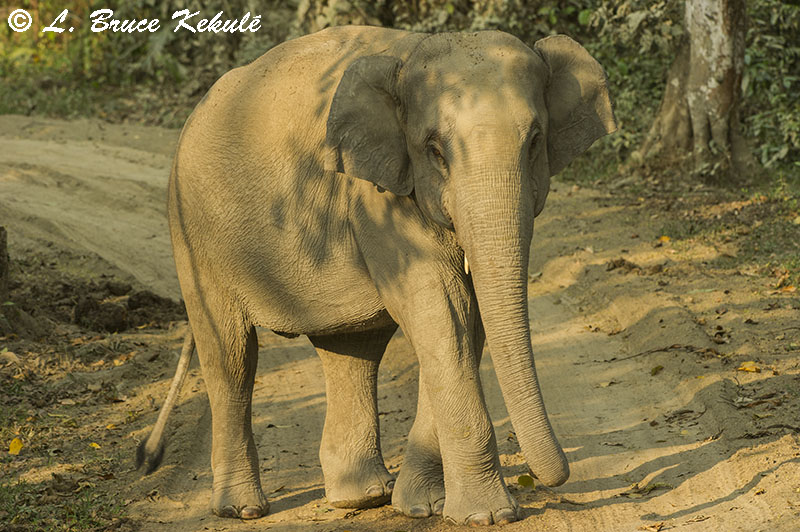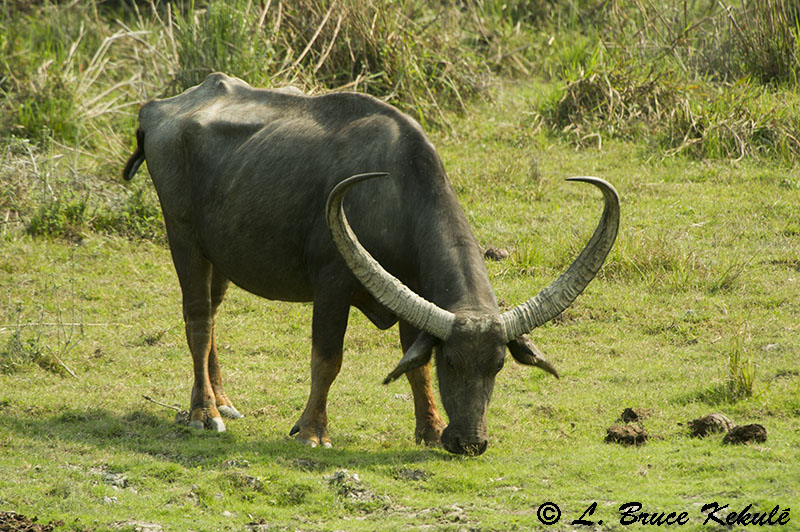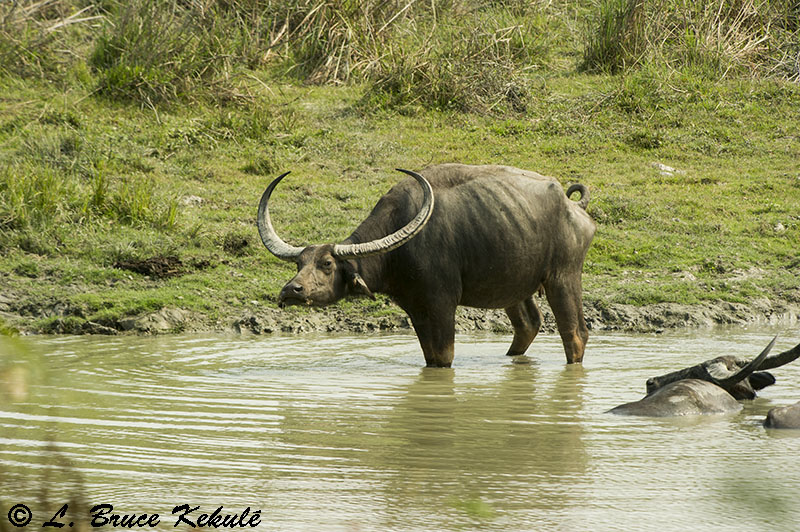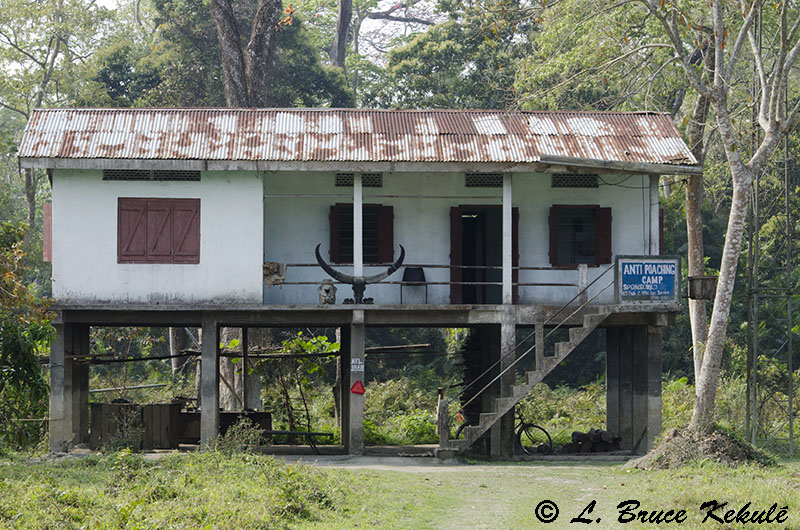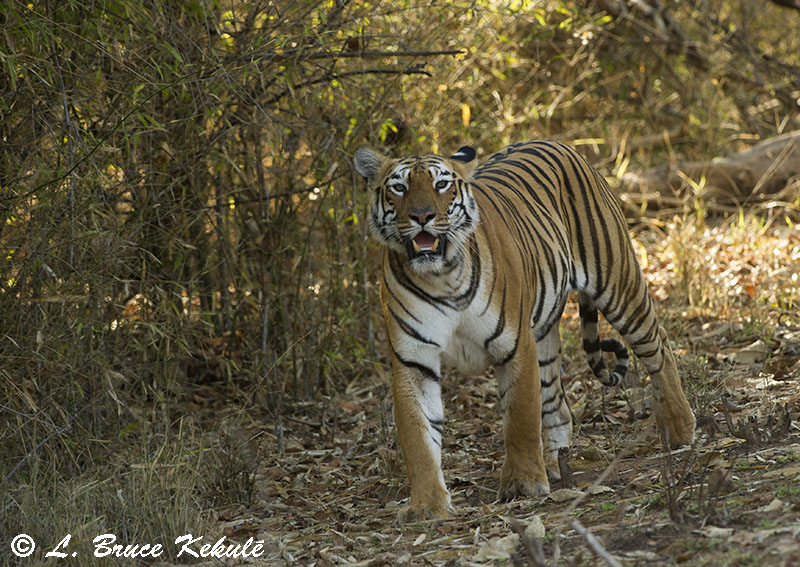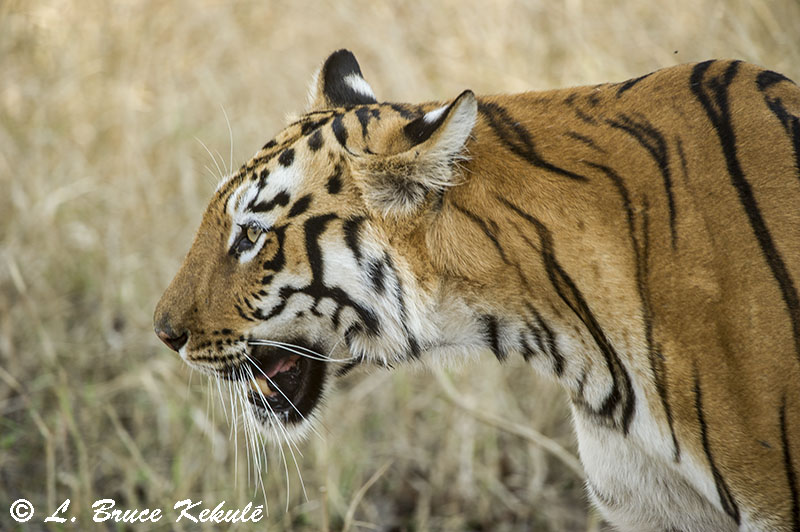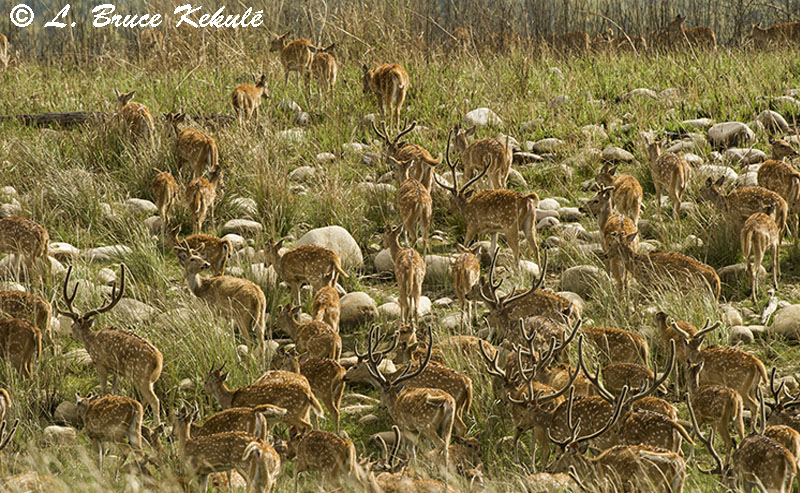Posts Tagged ‘India’
Nikon D3000 DSLR ‘travel cam’ catches a female tiger in India
Awhile back, I published a post on ‘my travel cam DSLRs’ on this forum and got some nice mongoose pics from that set last year. I have just wrapped up another trip to Northern India where I set one of my D3000s on a trail in a place called Vanghat resort and private wildlife reserve not far from Corbett Tiger Reserve in the State of Uttarakhand. After only two nights, a female tiger walked past the cam and tripped the sensor several times…this is the best shot from the series…Lady luck doing her magic once again…!!
Nikon D3000 with a 24mm manual lens – 2 SB-28s set at 1/4 power..!
Settings: ƒ8; 1/250 sec; ISO 400.
Pench Tiger Reserve: A fantastic trip with a close friend…!
An amazing forest in India’s Madhya Pradesh with some truly beautiful tigers…!
Collarwali on her way to the Pench River for an early morning drink…!
Being at the right place and right time always works. I arrived at the Tulie Tiger Corridor Resort close to Pench Tiger Reserve in the late evening of April 2nd and was greeted by my very good friend and naturalist, Omeer (Omi) Choudhary. As it was late and I was totally bushed from a long haul (airline flight from Ahmedabad in Gujarat visiting the Blackbuck-Velavadar National Park, and then a grueling 3-hour taxi ride from Nagpur), it was straight to bed for an early start the next morning.
Collarwali the next morning yawning after a long sleep…!
Up at five and after quick coffee and gate formalities, we entered the park at 6am and drove to the other side of the park (one hour drive) where the famous female tiger ‘Collarwali’ of Pench and her two cubs were being seen. That morning, I got a glimpse of ‘stripes in the grass’ and that was that. In the afternoon, one of her cubs was lying in the dense bush and I was able to get some good shots.
One of Collarwali cubs resting in the afternoon…!
The next morning however as we were sitting in the jeep waiting on some action, ‘Collarwali’ step out in front of us and walked down to the Pench River. It was great to see her again in lovely morning light. She is one of my favorite tigers in India…!
Collarwali’s other cub with mother in the back…!
The next morning and final day of my safari, I paid respects to the ‘Spirit of the Banyan Tree’ with a coconut and some joss sticks at the gate. After a 40-minute drive (short-cut), we found ‘Collarwali’ sleeping with a cub on a big rock and I got both of them together but at distance.
Raiyakassa, the dominant male tiger walking past the jeep all muddied up from a snooze in the big pond…!
In the afternoon very near closing time, we bumped into a leopard (rare for Pench) and I got a few shots. Then, as we were motoring back to the lodge just before the deadline of 6:30pm, we bumped into the dominant male (Collarwali’s mate Raiyakassa) walking towards us from the big pond. He was half covered in mud but still a magnificent creature and I was able to get a bunch of great images as he walked very close to our jeep. It was that good old ‘right time and right place’ and the ‘Spirit of the Banyan Tree’. What a fitting end to my second trip to Pench and I would like to thank Omi for his wonderful spirit and friendship…I will miss him..!
Raiyakassa caught head on…he is truly a beautiful male tiger and father of many of Collarwali’s cubs (22 cubs-6 litters)…!
As most people know now, Pench recently lost the Baghin Nala female and two of her cubs to poisoning on March 28th. This is very unfortunate for the park, Forest Department and people who love to see tigers. Fortunately, the other two cubs were saved and shifted to Kanha as they surely would have died too. It could take sometime for another big cat to fill this void and the danger will still be there of future poisonings.
On a good note, some of the poachers involved in this case have been apprehended and the others are being sought after. This incident plus others (27 tigers killed by poisoning and other circumstances in India since the Jan. 1st) is a growing trend and the ruthless Chinese tiger bone medicine devils are behind this. Somehow it must be stopped now or more tigers will be lost to this mindless draconian practice…!!
The Forests of Madhya Pradesh in India – Part Three
Pench National Park and Tiger Reserve
‘Collarwali’ and jackal…the little dog was faster and got away…she is old and has sired 22 cubs…but she still has class…!
In November, the weather is nice and crisp in the morning, as the winter season has just begun in Central India. When entering the forests in an open jeep, it becomes quite chilly first thing and a few layers of warm clothing are imperative. Then as the safari progresses and the sun climbs into the sky, it becomes warmer and those layers are pealed off. It’s a great time to be in the forests of Madhya Pradesh.
‘Collarwali’ on the run after the jackal…!
My time was up in Kanha, and I moved further southwest to the next great tiger reserve named Pench National Park and Tiger Reserve encompassing some 758 sq. kilometers. The taxi ride takes about three hours but is still stressful as is any two-lane highway in India. But again, I arrived in safety at the ‘Tuli Tiger Corridor’ lodge about 15 minutes from the main gate into the reserve.
‘Collarwali’ checking scent marking…!
That night before dinner, my naturalist Omveer Choudary gave me a run-down on what was going on in Pench. There was a female tiger with four cubs hanging around near the road and that our chances of seeing her was good. Also, the most famous female tiger in Pench named ‘Collarwali’ (a mother of 22 cubs) was also around. She was named because she has worn a collar for many years and the thing doesn’t even work now, but the authorities are worried about darting her with cubs and so have left it on. He said our chances were very good and this was coming from a guy who is a top-notch naturalist and driver for 12 years of experience here in Pench (he’s the boss). I was convinced.
The last time I saw ‘Collarwali’…she’s a magnificent big cat…!
The next morning after a quick cup of coffee and some crackers and cookies (standard breakfast fare while on safari in India), we jumped into the jeep at around 5am but it was not as cold as the other two tiger reserves I had just been to. We were the first in line at the gate, which was a good sign. I walked over to a ‘banyan’ tree close-by and wished for good luck. We entered but as the morning wore on, it looked like it would come-up dry.
My first tiger in Pench: She was the female with 4-cubs and it was a tight scene…!
Then, as we were more or less heading back for lunch, we bumped into a large group of jeeps parked on the road, and ‘Ome’ said, “it’s a tiger”. And there she was; the female with 4-cubs about 50 meters away from the road lying down in foliage and just her head showing. I just got glimpses of the cubs. I put a 1.7X tele-converter on my 200-400mm VRII lens to get a closer look and ripped off a bunch of shots.
Three-fanged tigress in the afternoon. She was the same tiger as in morning…!
That afternoon, we bumped into her again at another location close-by but she was still resting with her right side showing this time. Her left lower-fangs is broken. She eventually woke-up and my D3s did not stop shooting when she showed.
A sub-adult male tiger the 2nd morning…lady luck was talking…!
The next morning, we saw a sub-adult male lying down more than 50 meters away. Pench was becoming a favorite after two tigers in two days. Day three was good for other species like sambar, wild dog and jackal. And on day four at 6am in the morning we took a left turn at a junction several kilometers from the gate and all the other jeeps went straight. Around the corner and there she was: Collarwali standing in the road looking at us. Then she started walking towards us. She had her eyes on a jackal and actually chased after one but it was too quick for her. ‘Ome’ backed-up and she did not stop passing us out near the main road junction.
We followed her but the crowds began to show-up so we bugged-out. I had already got a bunch of nice shots of the most famous tigress there. I have no idea, but I really liked Pench and vowed to return again in 2016; and that is the plan for now. Jeep numbers are controlled and it is not too bad in the park like some of the other tiger reserves where it becomes a madhouse around a tiger.
Many thanks to all the staff at Tuli Tiger Corridor lodge and I would especially like to thank Omveer Choudary, my naturalist for a great time and passing on his wonderful knowledge, and to the Pench Forest Department.
Next and last stop on my journey: Satpura National Park and Tiger Reserve – where a monster croc lives…!
The Forests of Madhya Pradesh in India – Part Two
Kanha National Park and Tiger Reserve
A young female leopard in early morning in Kanha National Park and Tiger Reserve.
The next stop on my 20-day tiger safari through November 2015 to India was Kanha National Park and Tiger Reserve situated several hundred kilometers southwest of Bandhavgarh. I left the King’s Lodge in a nice air-conditioned taxi around noon and arrived at the Kanha Earth Lodge outside the park in the late afternoon. This was to be my home for the next four-nights and it was very pleasant with the bungalows built mainly from natural materials.
Kanha is quite famous for its tigers and other creatures like leopard and sloth bear. Prey species such as gaur and spotted deer (chital) also thrive in great numbers and play an important role as a food source for the big cats. The lush Sal and bamboo forests, grassy meadows and ravines of Kanha provided inspiration to Rudyard Kipling’s famous novel ‘Jungle Book’ and it lives up to its name as one of India’s best tiger reserves. However, it is a bit over-visited at the moment with hundreds of tourists visiting almost daily which has had an effect on the balance of nature.
A mature female tiger named ‘Bandri Chapar’ seen above a waterhole in Kanha National Park and Tiger Reserve.
That night before dinner, I met my naturalist ‘Mr Happy’ as he likes to be called. I mentioned the fact that being happy was the secret to my success as a wildlife photographer and that I wanted to visit the nearest banyan tree on the way into the park. He said he knew where one was just inside the gate and that we could stop the next morning.
That night after a few whiskey sun downers, I slept like a log after the hectic trip along narrow roads and near misses that day. It was early to bed and early to rise at 4am. After a quick coffee, we headed to the front gate and when we got there, were greeted by hundreds of people and scores of jeeps and cantors (buses) wanting to get in. It was a madhouse but I tried to just ignore it and hoped that once we got in, things would thin out which they did. We picked up a forest guide that is required by the forest department and he jumped in the back seat.
Here she is marking her territory spraying urine on a tree next to the waterhole.
About 100-meters from the gate, Mr. Happy stopped at the banyan tree but park regulations do not allow one to get out of the jeep. I just made a silent prayer for good luck and then we motored in. A short time later (about 15 minutes), it was still a bit dark as we traveled deeper and then the guide called out that a leopard had just jumped across the road. Mr. Happy reversed slightly and there stood a young female looking at us from about 10 meters away. I quickly snapped off a few shots and was able to get one good image of the young cat. Her pupils were dilated, as morning light was just filtering in.
Now this was some seriously good luck for Kanha where leopards are extremely difficult to see and photograph. My spirits jumped a thousand percent. Later that morning, we saw a sloth bear but it was out of range and it slipped into the thick forest. Then it went quiet for the next couple of days with hardly any tiger sightings around the whole park. Then on day-three as we were motoring along some man-made ponds, my guide spotted a female tiger named ‘Bandri Chapar’ walking parallel to the road and calling out for a mate with that unmistakable call of a female in heat. “raaaawr, raaaawr, raaaawr”…! We were the only jeep around and we just reversed following her, and I did not stop shooting my camera.
After crossing the road in front of us, ‘Bandri Chapar’ looked at me one more time.
After several hundred meters, she came up close to our jeep and crossed the road in front of us. She then stopped on my left side looking straight at me, and then slipped into the bush as other jeeps began to show up. Again, the spirits from the banyan tree had granted my wish with some seriously good luck as many people had not seen a tiger and it was becoming sad to see so many long faces as hardly anyone had seen the striped predator. I of course was beaming that I had photographed her. It doesn’t get any better than that..!
I also saw barasingha deer (hard ground swamp deer) and got some good shots. The species almost went extinct here but the forest department started a breeding program saving the species just in time. There are over 600 now living in the park. The magnificent bovine species guar, also thrive here and I got some good shots of two large bulls just a mere twenty meters away.
Barasingha stags and doe plus spotted deer at the back in the grasslands.
It was a great five days and I would like to thank all my friends at the Kanha Earth Lodge, Pugdundee Safaris and the Forest Department in Kanha.
Next stop: Pench National Park and Tiger Reserve
The Forests of Madhya Pradesh in India – Part One
A Safari to Four National Parks and Tiger Reserves
‘Ghost of the Darkness’…a leopard crossing the main road in Bandhavgarh on Dewali Day, Nov. 11th, 2015.
The short flight of only three and half hours from Bangkok to New Delhi is just about right for me in this day and age of long distance traveling. I had organized another safari to India from November 8-28th in order to fill my galleries of wildlife photos from there. This was my forth trip to the sub-continent and was on my way to the State of Madhya Pradesh in the central region. Four different protected areas or tiger reserves as they are called there were chosen for this jaunt.
The first afternoon was spent in Delhi to stock up on some snacks like raisins, nuts and dark chocolate, and to work on getting my kit together for the up-coming trips into the forest. I took my Nikon D3s and a Nikon 200-400 VRII prime lens plus a D300s with a 70-200 VRII as my second along with several other short lenses and equipment which included a Nikon D3000 camera trap and external flashes and sensor. It was early to bed for the next morning’s 2-hour flight to Jabalpur further south. Then it was a 3-hour taxi ride east to my first location on a 20-day trip. The King’s Lodge in Bandhavgarh would be my home for the next four days.
Sub-adult male from a tiger named Shukhi Patiya coming out of hiding.
Bandhavgarh National Park and Tiger Reserve is quite famous have been covered by National Geographic years ago when Michael “Nick” Nichols photographed tigers in the park. He also used camera traps and got some amazing images of the big cats over a year that were published in the magazine. BBC has also done several documentaries on tigers here. It is well visited by foreign and local tourists wanting to see these amazing carnivores up-close. However, they are not that easy to spot anymore in the dense forest found here and lot’s of luck is needed too.
There are three zones (1-2-3) that are allocated when the on-line bookings are made. My first three days in Zone One with morning and afternoon safaris turned up empty handed. The festival of Dewali (Festival of Light) was going on and the park was closed on the 11th Nov so I opted for a safari in the ‘buffer zone’ but again flipped out. On our way back to the lodge however, a leopard jumped in front of the jeep and I managed one abstract shot of the fast cat crossing the road. Luck was about to change for the better.
A tigress named ‘Dottie’ on the road in the afternoon and she was my second tiger that day.
The next morning, I was slated to go into Zone Two. This was my last day and I began to have my doubts that I would get a tiger, as sightings were very low. That morning while touring in the jeep, we met an Indian family and I stated that things had not been too good. The lady in the other jeep said my luck was about to change as I was under a Banyan Tree (Strangler Fig). We carried on for about 100 meters or so and turned a corner and, came face to face with another set of jeeps waiting on something about 50 meters away. It was a sub-adult male tiger hiding in the bush along side the road. He then stepped out of the forest and slowly crossed the road. My camera did not stop until he re-entered on the opposite side. Now, that is some serious luck in such a short time.
I could not believe what I had just seen and then remembered the ‘banyan tree’ and what the lady had said: buy a coconut, joss sticks and pray at a little shrine by the side of the road named ‘Ti Mama’. After lunch, we went into the market and got both items but as the gate was about to open, rushed back to Zone Two. About a half-hour in, we bumped into a mature female tiger named ‘Dottie’ standing in the road.
A chitlal or spotted deer buck: They are the main prey species for tiger in the park.
We were the only ones there and I did not stop shooting until she stepped into the forest on the other side. We went around the corner and we could just make her out as she laid down for a rest. Then the jeep hordes showed up and it turned into madness, as everyone wanted to see the tiger. The female finally got up and left, and that was that. Two tigers in one day! I would say my luck had changed and I felt really great at connecting with Mother Nature. We stopped by the little shrine on the way back to the lodge, and I thanked the spirits for some really great luck.
I would like to thank all my friends at the King’s Lodge, Pugdundee Safaris and the Forest Department in Bandhavgarh.
To be continued: Next is Kanha National Park and Tiger Reserve..!
An Apex-Predator straight from the Triassic Era
A Mugger Crocodile in Satpura Tiger Reserve.
A 4-meter mugger basking in the mid-morning sun – 10 minutes before the end of my finale safari…!
After almost 20 days of solid morning and afternoon safaris on hot dusty roads in India’s tiger reserves situated in the State of Madhya Pradesh, I decided to take a boat safari offered by the park authorities on my last safari at Satpura Tiger Reserve. Arriving around 7am at the boat dock, we jumped into a speedboat and then encountered many large water birds like grey heron and woolly-necked stork, plus many other species along the shoreline of Denwa Reservoir. Eventually, a mugger crocodile Crocodylus palustris was sighted but it quickly slipped into the lake.
As the morning got hotter and time was running out, another crocodile was seen but it too slid below. About 10 minutes before closing time as we were cruising back, a big crocodilian was seen in full bask mode with it’s mouth wide open bringing it’s body temperature up. A quick left and we closed the gap, and I did not stop shooting my Nikon D300s and 200-400 VR II on a tripod. It was about 4-meters long, and eventually got up and dropped off its little basking spot.
Lifting off from it’s favorite basking spot – a magnificent prehistoric creature of nature…!
I feel fortunate to have seen and photographed this prehistoric creature that evolved from the Triassic Era some 210 million years ago. In the lake, they are very shy for the most part. This is my top capture on my trip to the land of the tiger, and I will be posting more of all the other amazing creatures I photographed when time permits.
I would like to specially thank all my friends at the Denwa Backwater Escape and Pugdundee Safaris, plus the Forest Department at Satpura Tiger Reserve for all their help and support during my visit to this wonderful place..…!
The Good, the Bad and the Ugly: Ustad, the Indian tiger is jailed…!
Recently in Ranthambore National Park in India, was the center of controversy when a forest guard was killed by a big cat. Ustad or T-24 was blamed for the killing by the very ruthless, rich and powerful ‘hotel lobby’ just outside the park. T-24 had become shy of the large jeep hordes that invade the park everyday chasing after tigers. Many complaints that he was just too old, and a new younger tiger was needed to boost tourism and of course money. It is a conspiracy against wild tigers and one that is an ‘eye-sore’ to the country. Here is a short film showing the ‘Good, the Bad and the Ugly’ of tiger tourism in India…! Boycott Ranthambore until ‘Ustad’ is released back into the park and, his home and family…!
Kaziranga National Park and Tiger Reserve: The greatest protected area in the world
From a dozen great one-horned rhinos to over 2,400 individuals in just 80 years…!
Kaziranga, a UNESCO World Heritage Site is situated in the State of Assam in northeast India, and encompasses some 430 square kilometers of grasslands, wetlands and river habitat plus a buffer zone amounting to another 400 square kilometers. Over time, the Assamese have created the greatest protected area in the world.
A close-up of a rhino bull and a mynah birds looking for insects at sunset. There are
some 2,400 rhinos in Kaziranga making this place absolutely amazing in regards to
these creatures still thriving in the wild, and where one can actually see them.
A big tusker with nice ivory. There are some 1,000 elephants in the park and they
have also flourished because of the pristine habitat, food sources and great protection.
But they are also targeted by poachers but on a much lesser scale. It’s easy to see
them in all areas of Kaziranga as they go about their daily lives.
A pair of wild water buffalo cows at a waterhole. Along with the rhino and elephants,
these bovid have increased to 1,300 individuals. The Indian sub-species have the largest
horns of any creature in the world, and Kaziranga has the highest density of buffalo.
In most places, the African and Asian rhinos are in trouble and close to extinction, especially the Javan and Sumatran species. Rhinocerotidae have been on earth since the ‘Late Eocene or Early Oligocene’ (about 33 to 28.3 million years ago). Being odd-toed ungulates and herbivorous, they thrive in these grassland and wetlands that are supplied nutrients from the annual floods from the great Brahmaputra River.
This river flows from the Himalayas through the park in the northern section. This waterway is one of India’s main lifelines providing water to millions of people downstream along its entire length all the way to Bangladesh emptying into the Bay of Bengal. Annual floods bring nutrients to the land and the ecosystem is replenished.
Originally established as a reserve forest in 1908, Kaziranga was declared a sanctuary in 1916 to counter extensive poaching of the rhinoceros. In 1974, the Indian Government demarcated the present area as a national park. Then, in 2007, it was declared a tiger reserve under the Central Government’s ‘Project Tiger’ scheme.
Rhino gallery: Over four days, I photographed loads of these prehistoric looking
creatures in all three zones (West, Central and East)…! It was simply amazing…!
Eighty years ago, the rhino population was decimated to just a dozen or so beasts by poaching for their horn in demand by the Chinese and Vietnamese. The Assamese government decided to really put its foot down and instigated a policy to eradicate poachers using ‘extreme measures’ throughout the park, plus increasing the ranger force by several hundred percent.
The animal population immediately began to pick-up, and the last senses in 2014 estimated that some 2,400 rhino, 1,300 wild water buffalo and 1,000 elephant are thriving in this small park. Along with this, there are over 100 tigers that live here too and the park has one of the highest densities of the striped cat per square kilometer in the world. As a destination to see these majestic and iconic creatures, Kaziranga is the place to go.
Wild elephant gallery: I saw these herbivores every day and in all zones. There are over
1,000 of these giants in the park…!
The Assamese people are very proud of their heritage and the park is a ‘case study’ on how to actually save a species from extinction. All the large mammals propagate in safety and show the world; if you look after a place with a mandate to rid the protected area of poachers, animals will flourish. However, it turned into a small war and many people were actually killed including some rangers.
Even so in 2014, about 50 rhinos lost their horns and poachers killed three tigers. The battle continues and the government has done a brilliant job of saving nature with a tough mandate of ‘shoot to kill’ in order to protect this place.
It has worked so well that it is now possible to see rhino everyday, and just about everywhere, even outside the park. As I was leaving for the airport after four days on a recent safari in Feb. 2015, there were some cars parked by the side of the road and photographers had their cameras out taking images of a rhino a hundred meters from the tarmac.
Wild water buffalo gallery: There are more than 1,300 of these bovid and I saw them
everyday in all zones…! They have the largest horns in the animal kingdom….!
There are three zones (West, Central and East) that tourists are allowed to enter and it is scheduled by the lodge where you are staying on what areas one can visit. The Big Three (rhino, buffalo and elephants) can be seen in all areas. If you are lucky, a tiger may appear at any time. There are many bird species thriving and it is a bird watcher’s paradise.
The Park is home to more than 70 percent of the one-horned rhinoceros left in the world and harbors more than 60 percent of India’s wild water buffalo population along with the only population of Eastern swamp deer (or barasinga). Other important wildlife found are: gaur, leopard, fishing cat, large and small Indian civet, sambar, barking deer, hog deer, hog badger, Hoolock gibbon, capped langur, Assamese macaque, rhesus macaque, sloth bear, Gangetic dolphin and otter, etc.
A fresh tiger pug mark on the road in Kaziranga. I did not see a tiger here but got
a wonderful shot of a running tiger in the grassland of Corbett National Park
in northern India….!
From New Delhi, the flight to Guwhati in Assam takes about two hours and then it’s another four hours by taxi to the Infinity Lodge where I stayed situated close to the three Kaziranga park gates. There are many other hotels and lodges and one can find these on the Internet. There is also a bus service that passes the park. Traffic to the park is a bit hectic at certain times since it’s the main road in the northeast India to the next state of Nagaland, and on into Myanmar. It has been said that smugglers use this route for tiger bones and rhino horn to China.
Some of the rare birds thriving in Kaziranga: A female black stork identified by a
yellow iris near a waterhole; a Kalij pheasant in the forest; two bar-headed geese
in the wetlands, and a grey heron and pelican swimming in a pond….!
One thing for sure: the Forest Department here in Assam is one tough cookie. They have increased rangers to 700 men and women, and have 162 guard posts with 3-4 rangers living in each of these quarters. They do mainly foot patrols and are always armed with a least a rifle (mainly British .303s but some men have newer generation .315 Indian rifles that is lighter in weight than the old cumbersome English service arm) or sometimes 12 gauge shotguns. Some of the elite forest guards have assault rifles. While on any safari in Kaziranga, a forest guard with a rifle is mandatory in case of an emergency. The men do mostly foot patrols around their respective areas.
Kaziranga gallery: The park has seen some serious flooding and the most extreme levels
have been recorded shown here at a ranger station. Travel and viewing wildlife is normally
done in Maruti (Suzuki) type jeeps. Controlled burning of the grasslands carried out by the
Forest Department benefits the herbivores when new grass sprouts up….!
Needless to say, it is perfectly safe to travel in and around the park. An armed forest guard to ride ‘shotgun’ is mandatory and is picked up at the gate. For the most part, you’ll be able to see these beasts in a Maruti (Suzuki) safari type jeep called a ‘gypsy’. It is the best way to view wildlife and there are many operators at most of the lodges. The forest department also offers guided tours on an elephant-back to get up-close to the big beasts.
The best time to visit Kaziranga is from November to April. I used a Company named ‘Wilderness Uncut’ (wildernessuncut.com) for all my arrangements. Wildlife photographers Anu Marwah from New Delhi, and Jason Fernandes from Mumbai are co-owners and they organized everything to perfection. Their service is top-notch and I know who will arrange any future trips to India for me. Being wildlife photographers, they know what is needed for a successful trip.
That’s me with my naturalist Polash Borah, driver Mohammed Nekib Ali and a forest
ranger at a rest stop station early one morning during my recent safari.
I also had the pleasure of working with Polash Borah, my naturalist (17 years of experience in Kaziranga) and Mohammed Nekib Ali (10 years experience) my driver who also acts as a naturalist. We spent four days together and had a great time. They know exactly what are the best areas for viewing and photographing wildlife, and both work at the Infinity Lodge just outside the park.
May 1st is ‘World Rhino Day’ in India, and Kaziranga National Park and Tiger Reserve is the best place in the world to see these rare creatures up-close. If you are planning on visiting a protected area first hand and want to view Mother Nature’s giants, make arrangements to Assam; you won’t be disappointed…!
Travel Info:
From Thailand, one of the best airlines to travel to India is ‘Air India’ that has a daily flight leaving Bangkok around 8am and arriving in New Delhi at noon. Arriving in the daytime in Delhi is much better and safer than arriving after midnight like some of the other airlines do. A connecting flight on Indigo Airways to Guwhati in Assam is very good and takes about two hours. They are a budget airline and have several flights a day. I recommend these two carriers as being very reliable and reasonable in price. Give yourself at least three hours through the New Delhi domestic airport, as it is extremely busy and crowded. Finally, when flying a domestic airline, a maximum of 15 kilos for check-in baggage is the standard. Anything over that weight will be charged as excess.
India’s ‘Big Six’: Majestic creatures thriving on the sub-continent…!
A photographic tour in three national parks with some pretty amazing animals
A tigress on the run in the grassland at Dhikala, Corbett National Park in the northern State of Uttarakhand.
In 2014, I made a decision to visit India once again in search of the most iconic species still thriving in three protected areas in the northeast, central and northern parts of the country. Kaziranga, Tadoba and Corbett national parks and tiger reserves respectively, were chosen for their wildlife biodiversity with the tiger at the top of the list. I visited the three from February 22 through March 16, 2015.
A mature bull elephant with some impressive ivory in Kaziranga National Park.
I wanted to photograph the big six: elephant, rhino, gaur, wild water buffalo, leopard and the tiger. I was extremely lucky encountering all of these amazing animals during this trip. This has definitely left a huge impression on me and is etched in memory. India’s wildlife and protected areas are some of the best places in the world to see Mother Nature’s wonderful creatures.
Male One Horned Indian rhino 10 minutes from the front gate on my first day in Kaziranga National Park.
A century ago, India was teeming with wildlife. There were some 40,000 tigers found here but that number quickly dropped primarily due to habitat loss after World War II when the population really began to surge and forest areas were overcome, and turned into agriculture fields and estates. Hunting on a grand scale was also responsible for the disappearance of the tiger.
Wild water buffalo cow in Kaziranga National Park.
In 2011, there were only about 1,706 tigers left but in 2014 after better methodology and camera trapping, that number increased to 2,226 individuals found throughout the continent. As a result of mass awareness and conservation measures, the tiger population has rebounded showing a remarkable growth of 30% in the past three years. But some scientists believe this number to be inflated and put the amount of tigers around the 2,000 mark.
A bull gaur with an extremely long tongue in Tadoba National Park.
On 22nd of February 2015, I boarded Air India for the 4-hour flight from Bangkok to New Delhi arriving at noon. After a quick hair-raising taxi ride through the city, I got to the hotel spending one night to rest-up in order to catch the next morning’s flight to Gauhati, the largest city in the State of Assam in northeast India. The hustle and bustle through the domestic airport in Delhi is very tight on security as it should be. But once through the x-ray machines, a bit of a breather and a coffee is welcome. You must get there at least three hours early because of the amount of flights leaving, and the thousands of people trying to catch their respective connections.
A female leopard during late morning in Tadoba National Park.
Kaziranga National Park: State of Assam
A young bull elephant in Kaziranga National Park.
I wanted to visit Kaziranga National Park with the objective of finding out why this place is the number one protected area in the world, and my top priority was the Great Indian one-horned rhino, and then on my list was the wild water buffalo, elephant and tiger in that order. I got the big three but the tiger remained elusive.
A water buffalo photographed by my friend Polash Borah.
My newly acquired friends, Polash Borah and Mohammed Nekib Ali, my naturalist and driver respectively were a big help in locating these large mammals. I let Polash use my Nikon D7000 with a brand new Nikon 70-200mm VRII lens, and he got a really nice buffalo shot posted here. I also managed to get some good photographs myself. It was a great trip and I met some very nice people.
A young one-horned rhino up-close. He was a curious fellow wanting to know who we were.
I will be going back to Kaziranga maybe in November of this year when the skies are clear blue and the air is crisp wanting to get some nice scenic shots especially of the wide Brahmaputra River that runs through the park from the Himalayas in the background, and the lush swamps and grasslands after the monsoon rains.
A mature wild water buffalo bull near a waterway in Kaziranga National Park.
Probably the most important fact concerning Kaziranga is that some 80 years ago, there were about 12 rhinos left here. The Government of Assam decided to do something and implemented some serious laws with a ‘shoot-to-kill’ policy on all poachers and illegal squatters, plus an increase of several hundred personnel. At last count, there are 700 rangers and 161 ranger stations to look after a small 430 square kilometer core area, and a 400 square kilometer buffer zone. After a census last year, there are over 2,400 rhino, 1,500 wild water buffalo and 1,200 elephant. Over 120 tiger have been recorded here and prey species also number in the thousands. In my opinion, it is probably the best-protected area in the world…!
Tadoba National Park: State of Maharashtra
A tiger named ‘Maya’ in Tadoba National Park; she is the most famous tigress seen almost everyday.
After four days in Assam, I flew back to New Delhi for a two-day rest and then boarded a flight on March 3 in the morning down to Nagpur further south. Then a two-hour taxi ride was needed to Tadoba National Park and tiger reserve in the State of Maharashtra. Arriving at the lodge in mid-afternoon, a needed rest and some lunch was in order. I did not go out on safari that afternoon because the park is closed on this day.
‘Maya’ up-close as she walked the road marking her territory.
The next morning’s safari netted a beautiful female leopard highlighted by some wonderful back-light. My spirits were up a hundred percent after photographing the spotted cat.
Female leopard jumping in front of our jeep.
Female leopard up-close as she checks her surroundings.
The next morning as we were rolling around the dusty roads, we bumped into a big crowd of jeeps but they were at the far-end of a one-way road. We waited and saw a tiger walk out of the forest near the jeeps but melted back in. The group then moved close to us but the tiger stayed in the forest. My driver Lahu from the Tiger Trails Lodge has been driving for the owner of the lodge for some 35 years, and knew exactly where the big cat would come out. And as sure as the sun comes up everyday, she popped out and walked right in front of us.
‘Maya’, the female tiger queen in Tadoba National Park: This was my last sighting of this beautiful cat.
I did not stop shooting as Maya, (probably the most popular tigress in Tadoba at the moment) walked along the road spraying and marking her territory. My new friend Dr Sundran Rajendra was with me, and the both of us were so elated that we just kept on shooting our cameras. Then time was up and we had to leave the beautiful cat to herself. It was Sundran’s first tiger and he managed to get some very nice shots of the big cat. She came so close I could almost touch her.
Another tigress, named ‘Choti Tara’ fitted with a radio collar snarls at my friend Dharmendra Sharma.
My other friend and naturalist with the lodge Dharmendra Sharma, was in another jeep so I let him use my Nikon D7000 and the new Nikon 70-200mm VR II, and he got some very nice photos of another female named ‘Choti Tara’ fitted with a radio collar. He also got a few nice shots of Maya.
Male tiger named ‘Gabbar’ fitted with a ‘radio collar’ in pretty bad shape.
On my last afternoon safari in Tadoba, I bumped into ‘Gabbar’, a male tiger also fitted with a collar. He got swatted by another male and was in pretty bad shape. But the wheels are in motion to fix him up. I just hope that the squeaky Indian bureaucracy does not wait too long to help this tiger, as he could turn into a cattle killer or even worse, a man-eater. Needless to say, news on Facebook is that he did kill a village buffalo but is OK for the moment, and is being monitored. After four days, I was back on the plane to New Delhi for a two-day rest before heading north to India’s first national park.
Corbett National Park: State of Uttarakhand
A young tigress stalking a herd of spotted deer in the grassland of Corbett National Park.
It takes about four to five hours north of Delhi by taxi through some very congested and dangerous traffic in the State of Uttar Pradesh to get to Ramnagar, a city in the State of Uttarakhand where Corbett National Park, India’s first national Park. It is situated in the foothills of the great Himalayas. I spent the first night at the Forest Department’s lodge at Bijrani, and went on safari that afternoon and then again the next morning.
A golden jackal on the run near the Forest Department’s lodge at Bijrani.
I did not see a tiger but the big cats were around as other jeeps that I bumped into got some nice close-up photos taken with an iPhone. An occupant in one of the vehicles gave me a telephone slide show. I did see a pair of golden jackals early in the morning and then later a small family unit of elephants. One old cow did a mock charge and came within 15 meters but stopped short and turned around going back to her calf. The elephants then faded off into the forest.
Elephants near the Forest Department lodge at Bijrani.
Around 12-noon, we left this section and went over to the Forest Lodge at Dhikala that is the best site in Corbett to see tigers. Near the lodge, there is a grassland savannah that attracts herbivores like spotted deer in great numbers, and of course many tigers come looking for prey. It is said the park has some 200 tigers, one of the highest densities in India.
A herd of more than 100 spotted deer; the prime food source for tigers in Corbett National Park.
On the second morning, we bumped into a young hunting tigress stalking a herd of over a hundred deer. Me, my naturalist Devendra Singh Neui and my driver Rasheed Ali, were the only ones at this location as all the other jeeps from the lodge (about 10 of them) were waiting for tigers by the forest road. She tried several times unsuccessfully to chase down a deer but the herbivores were on to her. I managed to get some really great images in the process.
The tigress on the run after spotted deer not far from the Forest Department’s lodge at Dhikala.
Later in the afternoon, the camp was abuzz with the news that a tiger was in the lower grassland, and after lunch, they all headed that way and waited nearby. When she appeared, the group went wild chasing after her but they all came up short. We hung back and this very smart tiger circled around to avoid them. I saw her one more time slinking in the grass as the light was fading but time was up as I snapped a few last frames. I had a great time here and have vowed to return to this remarkable place…!
The unlucky tiger chasers in the grassland of Dhikala, Corbett National Park.
The trip to Corbett was scheduled on very short notice by my agents Anu Marwah in New Delhi, and Jason Fernandes in Mumbai both wildlife photographers of great standing in India. They are joint owners of Wilderness Uncut (wildernessuncut.com), a company set-up to cater to wildlife photographers, naturalists and bird watchers. Their superb management and arrangements are first class with absolutely no hiccups and they are reasonable priced. It was a great, enjoyable and memorable trip for me. I can honestly say that I need look no further for anyone to help me with any of my up-coming trips to India.
The female tiger in the grassland of Corbett: this was my last sighting of this beautiful tigress.
One point that I must make here! You never get tired of seeing the world’s biggest cat and is one of the greatest predators that ever walked the face of the Earth. My thoughts are always with these felines and their future survival. Unfortunately, the future for the tiger looks dim, as the situation concerning the Asian medicine trade using their bones seems to be getting worse with more and more stories on the net and in the papers about this draconian belief. The biggest culprits are China, Vietnam, Laos and Thailand (Chinese in Thailand) that perpetuate this market. The tiger needs the whole world to stand up to these people and this illicit trade must be stamped out soon but it carries on with impunity. Until action is taken with economic sanctions and other means against the countries involved, this illegal black-market will continue to take the wild tiger into the dark depths of extinction.

















